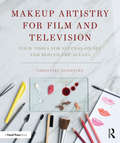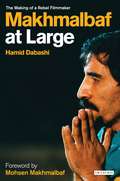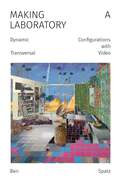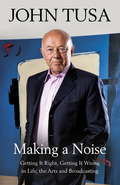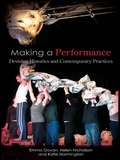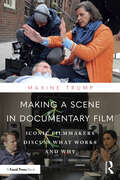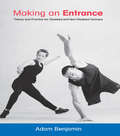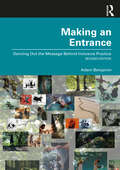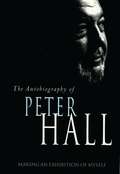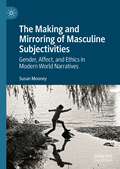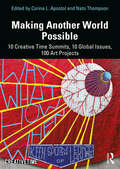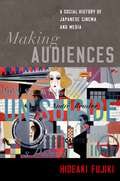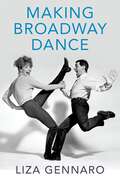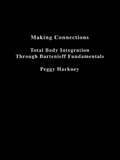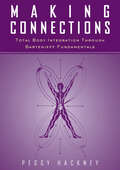- Table View
- List View
Makeup Artistry for Film and Television: Your Tools for Success On-Set and Behind-the-Scenes
by Christine SciortinoIn this comprehensive handbook author, makeup artist, and educator Christine Sciortino offers a detailed introduction to the conceptual foundations, techniques, and on-set practices of the makeup design process, going beyond technique-centered makeup education to provide an in-depth look at the workings of the film and television world. Through personal stories, interviews, demonstrations, and insights from Sciortino and her colleagues, this book explores the business of makeup artistry, including tailoring a resume, building a kit, self-marketing, breaking down a script, researching and creating makeup looks, working as part of a production team, and different ways to get paid. It further delves into on-set procedures and theory such as anatomy, skin science, color theory, and lighting design. With high-quality step-by-step photo tutorials, this book will help readers to learn and hone techniques for beauty makeup, character makeup, and light special effects including aging and dirtying, grooming, bruises and prosthetics, tattoos, and more. An emphasis is placed on working with actors of all ages, skin tones, and gender identities. This approachable and engaging blend of practical techniques and professional practice is ideal for both introductory-level and established artists. An online resource also offers downloadable templates and sample paperwork for on-set use and practice.
Makeup Artistry for Film and Television: Your Tools for Success On-Set and Behind-the-Scenes
by Christine SciortinoIn this comprehensive handbook author, makeup artist, and educator Christine Sciortino offers a detailed introduction to the conceptual foundations, techniques, and on-set practices of the makeup design process, going beyond technique-centered makeup education to provide an in-depth look at the workings of the film and television world. Through personal stories, interviews, demonstrations, and insights from Sciortino and her colleagues, this book explores the business of makeup artistry, including tailoring a resume, building a kit, self-marketing, breaking down a script, researching and creating makeup looks, working as part of a production team, and different ways to get paid. It further delves into on-set procedures and theory such as anatomy, skin science, color theory, and lighting design. With high-quality step-by-step photo tutorials, this book will help readers to learn and hone techniques for beauty makeup, character makeup, and light special effects including aging and dirtying, grooming, bruises and prosthetics, tattoos, and more. An emphasis is placed on working with actors of all ages, skin tones, and gender identities. This approachable and engaging blend of practical techniques and professional practice is ideal for both introductory-level and established artists. An online resource also offers downloadable templates and sample paperwork for on-set use and practice.
Makhmalbaf at Large: The Making of a Rebel Filmmaker
by Hamid DabashiThe name of Mohsen Makhmalbaf is almost synonymous with the dramatic rise of Iranian cinema in the aftermath of the Islamic Revolution, and over the last quarter of a century, his career as filmmaker and writer has reflected the tumultuous history of his homeland and the fate of its neighbours. Hamid Dabashi draws from his friendship with Makhmalbaf, as well as his direct involvement with Makhmalbaf's films and thought, to give us this deeply engaging book on the tumultuous life and spectacular career of a great filmmaker. This is also the account of Makhmalbaf's transformation, from committed Muslim revolutionary, who was jailed for his part in the revolution, into an artistic humanist of great energy and elegance. His films, including 'The Peddler' and 'The Time for Love', 'Salaam Cinema', 'Gabbeh', 'Silence' and 'Kandahar', confound conventional genres and are always surprising. They represent his own journey and take part in it, in ways that Dabashi explores with great insight. Makhmalbaf's cinematic career started in Iran and has since expanded into Turkey, Tajikistan, Afghanistan, Pakistan, India and into Europe. Dabashi uncovers how, moving across boundaries, Makhmalbaf's creative genius can illuminate our contemporary world.And this book is in part the story of a friendship. As Mohsen Makhmalbaf writes in its Preface: 'Hamid Dabashi - this pious atheist friend of mine, the man who loves cinema and hates art, this political activist who abhors politics, this thinking, pondering, critical intellect… I have learned much from him. Perhaps he too, has learned from me. The times he and I have spent together have been occasions of discovery and illumination.'
Making a Laboratory: Dynamic Configurations with Transversal Video
by Ben SpatzMaking a Laboratory defines a new audiovisual embodied research method that short-circuits experimental practice and video recording to generate new kinds of data and documents. Overturning conventional hierarchies of knowledge, “Dynamic Configurations with Transversal Video” (DCTV) grounds both discursive and audiovisual knowledges within the space of embodied practice, synthesizing insights from historical epistemologist Hans-Jörg Rheinberger and philosopher of science Karen Barad to offer the first rigorous definition of laboratoriality outside a techno-scientific paradigm. In this concise book, nonbinary practitioner-researcher Ben Spatz situates the DCTV method in the context of artistic research and alongside emerging audiovisual methods in other fields, while highlighting its unique characteristics. Across six focused chapters, Making a Laboratory introduces DCTV as a queer feminist adaptation of Jerzy Grotowski’s “poor” theater laboratory and defines its core elements, drawing on a range of thinkers including Giorgio Agamben, Rebecca Schneider, and Hito Steyerl, in order to examine power, identity, and documentation in lab practice. Drawing from the ethical consent practices of the BDSM community, it lays the groundwork for a radical reinvention of audiovisuality from the perspective of embodiment — the audiovisual body.
Making a Noise: Getting It Right, Getting It Wrong in Life, Arts and Broadcasting
by Sir John TusaJohn Tusa is a distinguished journalist, broadcaster and leader of arts organisations, best remembered for his times at the BBC, including creating Newsnight.Tusa's memoir is etched with candour. His account of two years of internecine warfare at the top of the BBC under the Chairman, 'Dukey' Hussey will go down as a major contribution to BBC history. His recollections of a hilarious and petty-minded few months as head of a Cambridge college will be read as a case study of the absurdities of academic life; while running the rejected and maligned Barbican Centre, Tusa led its recovery into the major cultural centre that it is today.
Making a Performance: Devising Histories and Contemporary Practices
by Emma Govan Helen Nicholson Katie NormingtonMaking a Performance traces innovations in devised performance from early theatrical experiments in the twentieth-century to the radical performances of the twenty-first century. This introduction to the theory, history and practice of devised performance explores how performance-makers have built on the experimental aesthetic traditions of the past. It looks to companies as diverse as Australia's Legs on the Wall, Britain's Forced Entertainment and the USA-based Goat Island to show how contemporary practitioners challenge orthodoxies to develop new theatrical languages. Designed to be accessible to both scholars and practitioners, this study offers clear, practical examples of concepts and ideas that have shaped some of the most vibrant and experimental practices in contemporary performance.
Making a Performance: Devising Histories and Contemporary Practices
by Emma Govan Helen Nicholson Katie NormingtonMaking a Performance traces innovations in devised performance from early theatrical experiments in the twentieth-century to the radical performances of the twenty-first century. This introduction to the theory, history and practice of devised performance explores how performance-makers have built on the experimental aesthetic traditions of the past. It looks to companies as diverse as Australia's Legs on the Wall, Britain's Forced Entertainment and the USA-based Goat Island to show how contemporary practitioners challenge orthodoxies to develop new theatrical languages. Designed to be accessible to both scholars and practitioners, this study offers clear, practical examples of concepts and ideas that have shaped some of the most vibrant and experimental practices in contemporary performance.
Making a Scene in Documentary Film: Iconic Filmmakers Discuss What Works and Why
by Maxine TrumpThis collection of iconic interviews helps demystify the documentary filmmaking process by deconstructing the most relevant and important scenes in some of today's most well-known documentary films. It offers concrete, real-world examples of the situations and decisions that filmmakers navigate. We go behind the scenes with the creators to learn the methodologies and approaches these directors, cinematographers, editors, and sound recordists have taken to bring these amazing documentaries to life. What makes a great scene? Why are they so important in the construction of a great film? The interviews included offer excellent insights from the directors of the award-winning The Truffle Hunters, My Octopus Teacher, Collective, Knock Down the House, and Trapped; the cinematographer of RBG, Julia, and Fauci; the editor of Time; and sound recordist of Tiger King. Award-winning documentary filmmaker and esteemed Sundance advisor Maxine Trump goes in-depth with each filmmaker, asking about their creative process. Why did these scenes make such a deep impression on both the filmmakers and their audience? Was it the cinematic style, the dynamic dialogue, the magic of observational filmmaking, or a surprising turning point?This technical but creative and accessible resource is suitable for documentary filmmakers, aspiring directors, producers, editors, and cinematographers of non-fiction film. Each interview offers a fresh perspective to the emerging or professional filmmaker and audience alike.
Making a Scene in Documentary Film: Iconic Filmmakers Discuss What Works and Why
by Maxine TrumpThis collection of iconic interviews helps demystify the documentary filmmaking process by deconstructing the most relevant and important scenes in some of today's most well-known documentary films. It offers concrete, real-world examples of the situations and decisions that filmmakers navigate. We go behind the scenes with the creators to learn the methodologies and approaches these directors, cinematographers, editors, and sound recordists have taken to bring these amazing documentaries to life. What makes a great scene? Why are they so important in the construction of a great film? The interviews included offer excellent insights from the directors of the award-winning The Truffle Hunters, My Octopus Teacher, Collective, Knock Down the House, and Trapped; the cinematographer of RBG, Julia, and Fauci; the editor of Time; and sound recordist of Tiger King. Award-winning documentary filmmaker and esteemed Sundance advisor Maxine Trump goes in-depth with each filmmaker, asking about their creative process. Why did these scenes make such a deep impression on both the filmmakers and their audience? Was it the cinematic style, the dynamic dialogue, the magic of observational filmmaking, or a surprising turning point?This technical but creative and accessible resource is suitable for documentary filmmakers, aspiring directors, producers, editors, and cinematographers of non-fiction film. Each interview offers a fresh perspective to the emerging or professional filmmaker and audience alike.
Making an Entrance: Theory and Practice for Disabled and Non-Disabled Dancers
by Adam BenjaminMaking an Entrance is the first ever practical introduction to teaching dance with disabled and non disabled students. This clearly written, thought provoking and hugely enjoyable manual is essential reading whether you're just starting out or are already active in the field.Taking improvisation as his focus and as the starting point of choreographic exploration, Adam Benjamin asks what it has to offer as an art form and how it can be better used to meet the changing needs of dance education.In the theoretical section Benjamin explores the history of a disintegrated dance practice, placing it within the wider context of cultural and political movements. He questions what is meant today when we talk about 'inclusive' or 'integrated dance' and what we might expect of it.The book includes over 50 exercises and improvisations designed to stimulate and challenge students at all levels of dance. Benjamin also includes useful hints on the practicalities of setting up workshops covering issues as diverse a class size, the safety aspects of wheelchairs and the accessibility of dance spaces.
Making an Entrance: Theory and Practice for Disabled and Non-Disabled Dancers
by Adam BenjaminMaking an Entrance is the first ever practical introduction to teaching dance with disabled and non disabled students. This clearly written, thought provoking and hugely enjoyable manual is essential reading whether you're just starting out or are already active in the field.Taking improvisation as his focus and as the starting point of choreographic exploration, Adam Benjamin asks what it has to offer as an art form and how it can be better used to meet the changing needs of dance education.In the theoretical section Benjamin explores the history of a disintegrated dance practice, placing it within the wider context of cultural and political movements. He questions what is meant today when we talk about 'inclusive' or 'integrated dance' and what we might expect of it.The book includes over 50 exercises and improvisations designed to stimulate and challenge students at all levels of dance. Benjamin also includes useful hints on the practicalities of setting up workshops covering issues as diverse a class size, the safety aspects of wheelchairs and the accessibility of dance spaces.
Making an Entrance: Dancing Out the Message Behind Inclusive Practice
by Adam BenjaminThis second edition of Making an Entrance is a practical and thought-provoking introduction to teaching dance with disabled and non-disabled students, updated with expanded coverage, new and revised exercises, and chapters that cover post-pandemic and online practice, diversity and inclusivity. With improvisation as his central concern Benjamin covers an extensive range of topics, including new autoethnographic writing, mental health, performance, feedback, and The Dancers’ Forest, and interrogates what we mean when we talk about ‘inclusive’ and ‘integrated dance.’ There are over 50 stimulating and challenging exercises purposefully designed for dance students of all levels accompanied by teaching notes, and examples drawn from the author’s experience as a teacher, performer, and dance maker. Useful hints are provided on the practicalities of setting up workshops covering issues such as class sizes, the safety aspects of wheelchairs and accessibility. An essential read for both students and teachers of improvisation who are seeking ways to engage with issues of diversity, written to be accessible whilst offering areas of increasing complexity and challenge for more experienced practitioners.
Making an Entrance: Dancing Out the Message Behind Inclusive Practice
by Adam BenjaminThis second edition of Making an Entrance is a practical and thought-provoking introduction to teaching dance with disabled and non-disabled students, updated with expanded coverage, new and revised exercises, and chapters that cover post-pandemic and online practice, diversity and inclusivity. With improvisation as his central concern Benjamin covers an extensive range of topics, including new autoethnographic writing, mental health, performance, feedback, and The Dancers’ Forest, and interrogates what we mean when we talk about ‘inclusive’ and ‘integrated dance.’ There are over 50 stimulating and challenging exercises purposefully designed for dance students of all levels accompanied by teaching notes, and examples drawn from the author’s experience as a teacher, performer, and dance maker. Useful hints are provided on the practicalities of setting up workshops covering issues such as class sizes, the safety aspects of wheelchairs and accessibility. An essential read for both students and teachers of improvisation who are seeking ways to engage with issues of diversity, written to be accessible whilst offering areas of increasing complexity and challenge for more experienced practitioners.
Making an Exhibition of Myself: The Autobiography of Peter Hall
by Peter HallThe story of a railway worker’s son who became one of the most powerful, outspoken and charismatic figures in European theatre. Sir Peter Hall has been director of the Royal Shakespeare Company, artistic director of Glyndebourne, and director of Britain’s National Theatre from 1973 to 1988. He has directed over 150 productions of plays, operas and films, and now runs his own acclaimed theatre company
The Making and Mirroring of Masculine Subjectivities: Gender, Affect, and Ethics in Modern World Narratives
by Susan MooneyThis book shows how diverse, critical modern world narratives in prose fiction and film emphasize masculine subjectivities through affects and ethics. Highlighting diverse affects and mental states in subjective voices and modes, modern narratives reveal men as feeling, intersubjective beings, and not as detached masters of master narratives. Modern novels and films suggest that masculine subjectivities originate paradoxically from a combination of copying and negation, surplus and lack, sameness and alterity: among fathers and sons, siblings and others. In this comparative study of more than 30 diverse world narratives, Mooney deftly uses psychoanalytic thought, narrative theories of first- and third-person narrators, and Levinasian and feminist ethics of care, creativity, honor, and proximity. We gain a nuanced picture of diverse postpaternal postgentlemen emerging out of older character structures of the knight and gentleman.
Making Another World Possible: 10 Creative Time Summits, 10 Global Issues, 100 Art Projects
by Corina L. Apostol Nato ThompsonMaking Another World Possible offers a broad look at an array of socially engaged cultural practices that have become increasingly visible in the past decade, across diverse fields such as visual art, performance, theater, activism, architecture, urban planning, pedagogy, and ecology. Part I of the book introduces the reader to the field of socially engaged art and cultural practice, spanning the past ten years of dynamism and development. Part II presents a visually striking summary of key events from 1945 to the present, offering an expansive view of socially engaged art throughout history, and Part III offers an overview of the current state of the field, elucidating some of the key issues facing practitioners and communities. Finally, Part IV identifies ten global issues and, in turn, documents 100 key artistic projects from around the world to illustrate the various critical, aesthetic and political modes in which artists, cultural workers, and communities are responding to these issues from their specific local contexts. This is a much needed and timely archive that broadens and deepens the conversation on socially engaged art and culture. It includes commissioned essays from noted critics, practitioners, and theorists in the field, as well as key examples that allow insights into methodologies, contextualize the conditions of sites, and broaden the range of what constitutes an engaged culture. Of interest to a wide range of readers, from practitioners and scholars of performance to curators and historians, Making Another World Possible offers both breadth and depth, spanning history and individual works, to offer a unique insight into the field of socially engaged art.
Making Another World Possible: 10 Creative Time Summits, 10 Global Issues, 100 Art Projects
by Corina L. Apostol Nato ThompsonMaking Another World Possible offers a broad look at an array of socially engaged cultural practices that have become increasingly visible in the past decade, across diverse fields such as visual art, performance, theater, activism, architecture, urban planning, pedagogy, and ecology. Part I of the book introduces the reader to the field of socially engaged art and cultural practice, spanning the past ten years of dynamism and development. Part II presents a visually striking summary of key events from 1945 to the present, offering an expansive view of socially engaged art throughout history, and Part III offers an overview of the current state of the field, elucidating some of the key issues facing practitioners and communities. Finally, Part IV identifies ten global issues and, in turn, documents 100 key artistic projects from around the world to illustrate the various critical, aesthetic and political modes in which artists, cultural workers, and communities are responding to these issues from their specific local contexts. This is a much needed and timely archive that broadens and deepens the conversation on socially engaged art and culture. It includes commissioned essays from noted critics, practitioners, and theorists in the field, as well as key examples that allow insights into methodologies, contextualize the conditions of sites, and broaden the range of what constitutes an engaged culture. Of interest to a wide range of readers, from practitioners and scholars of performance to curators and historians, Making Another World Possible offers both breadth and depth, spanning history and individual works, to offer a unique insight into the field of socially engaged art.
Making Audiences: A Social History of Japanese Cinema and Media
by Hideaki FujikiFilm has always been a key technology for producing and disseminating attachments to 'the social.' Making Audiences explores the century-old relationships between Japanese media and social subjects, analyzing the connections between cinema audiences and five significant discursive terms: minshu (the people), kokumin (the national populace), toa minzoku (the East Asian race), taishu (the masses), and shimin (citizens). Fujiki narrates the history of Japan's transmedia ecology, illuminating cinema's enmeshment with other forms of media, from vaudeville to the internet, so that cinema audiences emerge as simultaneously shaped by and shaping social history. His extensive empirical research and commitment to interdisciplinarity bring new perspective to the history of Japanese society and culture in its global context from the early twentieth century up to the beginning of the twenty-first century, setting his insights within the context of total wars, imperialism, gender, ethnicity, mass society and communication, the ethics of care, citizenship, globalization, neoliberalism, social movements, digital media, and public and intimate spheres. By reorganizing the study of film and its audiences as central players of the history and politics of the 20th century, Fujiki writes the history of Japan and East Asia anew.
Making Audiences: A Social History of Japanese Cinema and Media
by Hideaki FujikiFilm has always been a key technology for producing and disseminating attachments to 'the social.' Making Audiences explores the century-old relationships between Japanese media and social subjects, analyzing the connections between cinema audiences and five significant discursive terms: minshu (the people), kokumin (the national populace), toa minzoku (the East Asian race), taishu (the masses), and shimin (citizens). Fujiki narrates the history of Japan's transmedia ecology, illuminating cinema's enmeshment with other forms of media, from vaudeville to the internet, so that cinema audiences emerge as simultaneously shaped by and shaping social history. His extensive empirical research and commitment to interdisciplinarity bring new perspective to the history of Japanese society and culture in its global context from the early twentieth century up to the beginning of the twenty-first century, setting his insights within the context of total wars, imperialism, gender, ethnicity, mass society and communication, the ethics of care, citizenship, globalization, neoliberalism, social movements, digital media, and public and intimate spheres. By reorganizing the study of film and its audiences as central players of the history and politics of the 20th century, Fujiki writes the history of Japan and East Asia anew.
Making Broadway Dance
by Liza GennaroThrough in-depth analysis of musical theatre choreography and choreographers, Making Broadway Dance challenges long-held perceptions of Broadway dance as kitsch, disposable, a dance form created without artistic process. Setting out to demonstrate that musical theatre dance is not a monolith but rather multi-varied in terms of dance styles, aesthetics and methodologies, author Liza Gennaro provides insights into how Broadway dance is made. By examining choreography for musical theatre through the lens of dance studies, script analysis, movement research and dramaturgical inquiry, she treads in uncharted territory by offering a close examination of a dance form that has heretofore received only the most superficial interrogation. She also explores how musical theatre choreographers create within the parameters of librettos, enhance character development and build dance languages that inform and propel narrative. By considering influences from ballet, modern, postmodern, Jazz, social and global dance, she reveals a rich understanding of musical theatre dance. This book exposes the choreographic systems of some of Broadway's most influential dance-makers including George Balanchine, Agnes de Mille, Jerome Robbins, Katherine Dunham, Bob Fosse, Savion Glover, Sergio Trujillo, Steven Hoggett and Camille Brown, and is essential reading for theatre and dance scholars, students, practitioners, and Broadway fans.
Making Broadway Dance
by Liza GennaroThrough in-depth analysis of musical theatre choreography and choreographers, Making Broadway Dance challenges long-held perceptions of Broadway dance as kitsch, disposable, a dance form created without artistic process. Setting out to demonstrate that musical theatre dance is not a monolith but rather multi-varied in terms of dance styles, aesthetics and methodologies, author Liza Gennaro provides insights into how Broadway dance is made. By examining choreography for musical theatre through the lens of dance studies, script analysis, movement research and dramaturgical inquiry, she treads in uncharted territory by offering a close examination of a dance form that has heretofore received only the most superficial interrogation. She also explores how musical theatre choreographers create within the parameters of librettos, enhance character development and build dance languages that inform and propel narrative. By considering influences from ballet, modern, postmodern, Jazz, social and global dance, she reveals a rich understanding of musical theatre dance. This book exposes the choreographic systems of some of Broadway's most influential dance-makers including George Balanchine, Agnes de Mille, Jerome Robbins, Katherine Dunham, Bob Fosse, Savion Glover, Sergio Trujillo, Steven Hoggett and Camille Brown, and is essential reading for theatre and dance scholars, students, practitioners, and Broadway fans.
Making Connections: Total Body Integration Through Bartenieff Fundamentals
by Peggy HackneyHuman movement influences an individual's perceptions and ability to interact with the world. Through exercises, illustrations, and detailed anatomical drawings, this remarkable book guides the reader toward total body integration. An experimental approach to movement fundamentals involving the patterning of connections in the body according to principles of efficient movement, the process of total body integration encourages personal expression and full psychological involvement.
Making Connections: Total Body Integration Through Bartenieff Fundamentals
by Peggy HackneyHuman movement influences an individual's perceptions and ability to interact with the world. Through exercises, illustrations, and detailed anatomical drawings, this remarkable book guides the reader toward total body integration. An experimental approach to movement fundamentals involving the patterning of connections in the body according to principles of efficient movement, the process of total body integration encourages personal expression and full psychological involvement.
Making Connections: Total Body Integration Through Bartenieff Fundamentals
by Peggy HackneyThis book explores how we go about creating the connections within us that allow us to become fully embodied human beings in the world. It provides some very personal memories of Irmgard Bartenieff and the development of her approach to Fundamentals.
Making Connections: Total Body Integration Through Bartenieff Fundamentals
by Peggy HackneyThis book explores how we go about creating the connections within us that allow us to become fully embodied human beings in the world. It provides some very personal memories of Irmgard Bartenieff and the development of her approach to Fundamentals.
